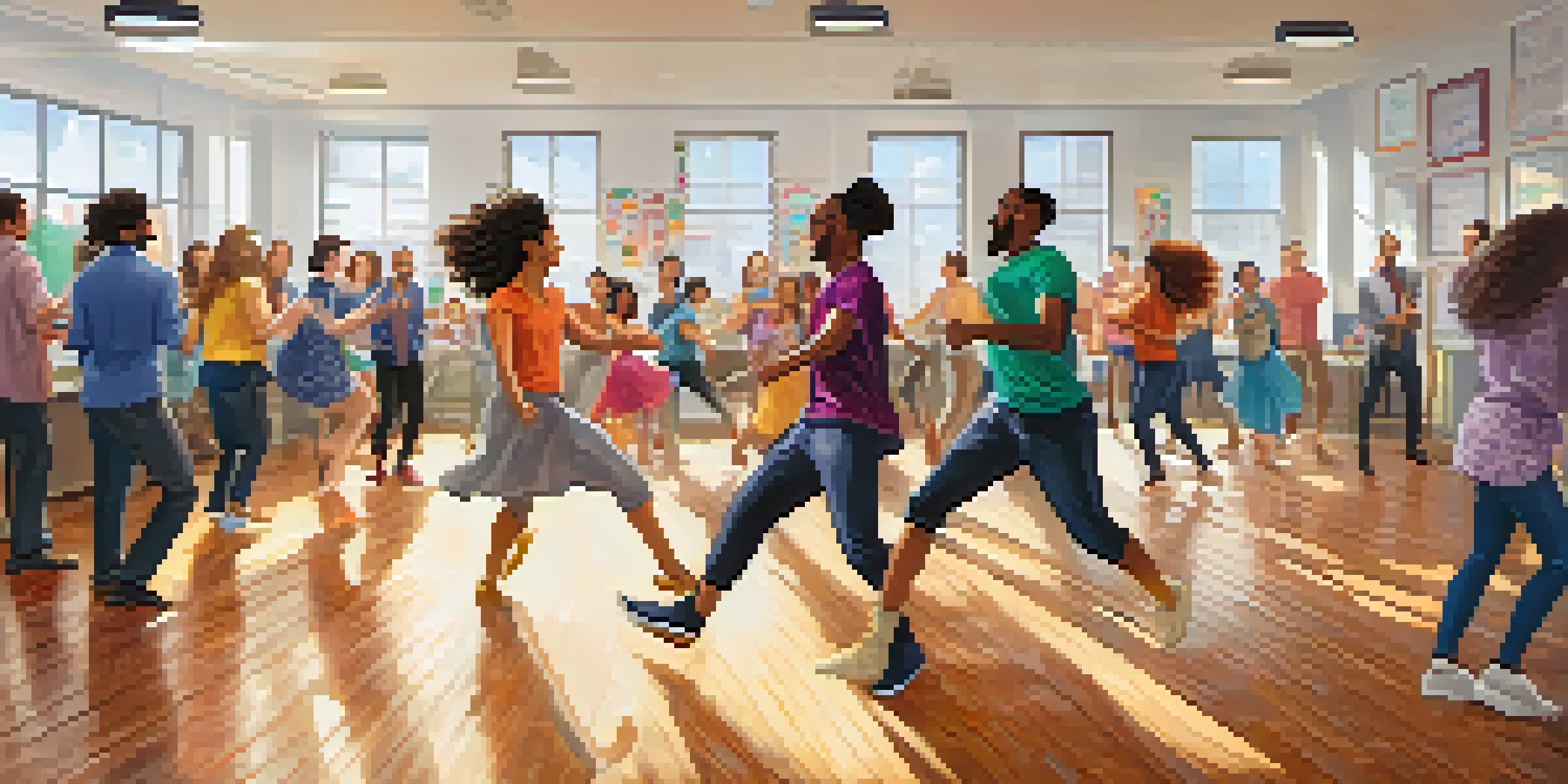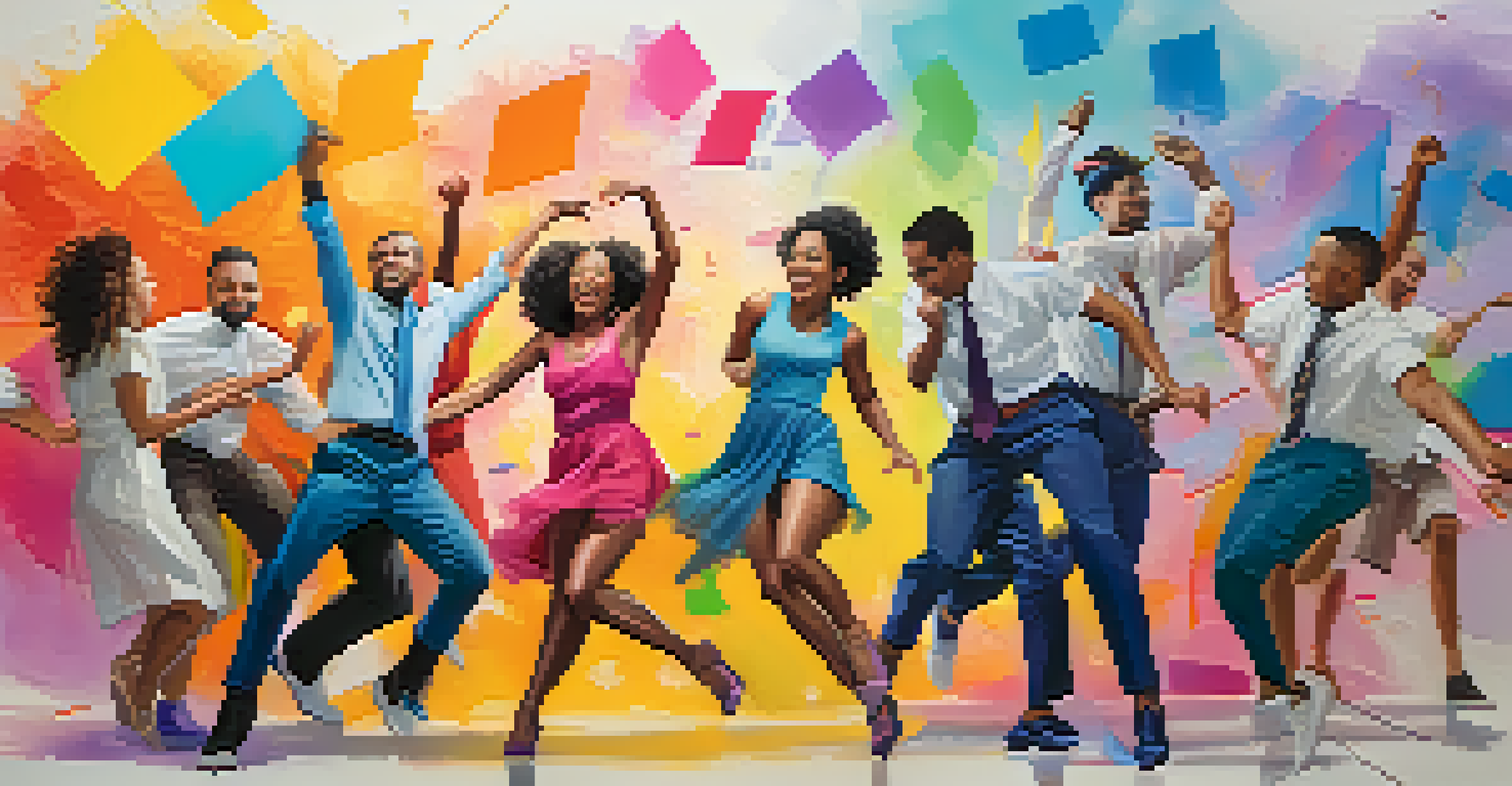Dance as a Tool for Creative Problem Solving at Work

Understanding Dance as a Creative Outlet
Dance is not just an art form; it's a powerful tool for self-expression. When employees engage in dance, they tap into their creativity and emotions, which can lead to innovative thinking. This creative outlet allows individuals to break free from conventional thought patterns and explore new ideas.
Dance is the hidden language of the soul.
Imagine a team stuck on a project, brainstorming around a table. Now, picture them moving to music, letting their bodies express their thoughts. This shift in environment can spark fresh perspectives and inspire innovative solutions that might not surface in a typical meeting.
By incorporating dance into the workplace, companies can foster an environment that values creativity. This not only helps in problem-solving but also enhances team bonding and morale, making it a win-win situation for everyone involved.
How Movement Enhances Cognitive Function
Research shows that physical movement can significantly enhance cognitive function. When we dance, our brain releases endorphins, which improve mood and focus. This boost in mental clarity can lead to better decision-making and problem-solving skills.

Think of it like a mental reset. Just as a computer slows down without a reboot, our minds can become cluttered. Taking a dance break can clear away this mental fog, allowing for sharper thinking and improved creativity when tackling complex issues.
Dance Boosts Creativity and Innovation
Engaging in dance can help employees break free from conventional thought patterns, sparking fresh ideas and innovative solutions.
Incorporating short dance sessions into the workday can result in a more energized and focused workforce. It helps individuals approach challenges with a refreshed mindset, ready to explore innovative solutions.
Building Team Cohesion Through Dance
Dance is inherently social, and participating in it as a team can strengthen relationships. When coworkers dance together, they share laughter and joy, breaking down barriers and fostering a sense of unity. This team cohesion is vital for effective collaboration.
Creativity takes courage.
Consider a team-building workshop where employees engage in a dance class. As they learn new moves, they not only improve their coordination but also build trust and camaraderie. These shared experiences create a supportive atmosphere that enhances teamwork.
When team members feel connected, they are more likely to communicate openly and share ideas. This openness can lead to creative problem-solving, as individuals feel safe to express unconventional thoughts and solutions.
Dance as a Stress Reliever for Improved Focus
Workplace stress can hinder creativity and problem-solving abilities. Dance serves as an excellent stress reliever, allowing individuals to express their emotions and release pent-up tension. This release can lead to a more focused and productive workforce.
Imagine a stressful day filled with deadlines. A short dance break can shift the mood and provide a refreshing pause. This shift not only alleviates stress but also helps employees return to their tasks with renewed energy and clarity.
Movement Enhances Focus and Clarity
Physical movement, like dancing, releases endorphins that improve mood and mental clarity, leading to better problem-solving skills.
By promoting dance as a stress-relief activity, companies can create a healthier work environment. Employees who feel less stressed are more likely to approach challenges with a positive mindset and innovative solutions.
Cultivating Innovation Through Dance Workshops
Implementing dance workshops in the workplace can be a fun way to stimulate creativity. These workshops encourage employees to step out of their comfort zones and explore new ways of thinking. The result? An influx of innovative ideas and approaches to problem-solving.
Think about a scenario where employees participate in a choreography session. As they learn to express their ideas through movement, they may discover unique perspectives on projects they previously found challenging. This newfound creativity can lead to breakthrough solutions.
Offering ongoing dance workshops can promote a culture of innovation. As employees embrace creativity through movement, they become more comfortable with exploring unconventional ideas, ultimately benefiting the organization.
Embracing Diversity in Movement Styles
Dance encompasses a wide range of styles, each with its unique cultural significance. Embracing this diversity in movement can enhance creative problem-solving by exposing employees to different perspectives. It encourages an appreciation for varied approaches and ideas.
For instance, incorporating various dance styles into team activities can spark discussions about cultural differences and creative expressions. This not only enriches the workplace culture but also fosters inclusivity and collaboration.
Strengthening Team Bonds Through Dance
Participating in dance together fosters trust and camaraderie among coworkers, enhancing collaboration and open communication.
When employees are encouraged to share their dance backgrounds, it can lead to exciting brainstorming sessions. These diverse influences can inspire innovative solutions and drive team creativity to new heights.
Implementing Dance in the Workplace: Practical Steps
To incorporate dance effectively in the workplace, start with small, manageable steps. Consider scheduling regular dance breaks or workshops during team meetings. These short bursts of movement can energize employees and stimulate creative thinking.
You might also explore partnerships with local dance instructors to provide classes tailored to your team's needs. This not only promotes physical activity but also instills a sense of community as employees learn and grow together.

Finally, encourage employees to share their experiences with dance. By creating a culture that values movement and creativity, you’ll foster an environment where innovative problem-solving can thrive, ultimately benefiting the organization.